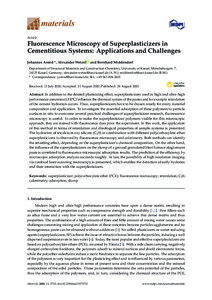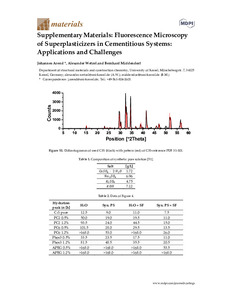Fluorescence Microscopy of Superplasticizers in Cementitious Systems: Applications and Challenges
| dc.date.accessioned | 2020-10-02T12:02:21Z | |
| dc.date.available | 2020-10-02T12:02:21Z | |
| dc.date.issued | 2020-08-24 | |
| dc.identifier | doi:10.17170/kobra-202009301863 | |
| dc.identifier.uri | http://hdl.handle.net/123456789/11844 | |
| dc.description.sponsorship | Gefördert durch den Publikationsfonds der Universität Kassel | ger |
| dc.language.iso | eng | eng |
| dc.rights | Namensnennung 4.0 International | * |
| dc.rights.uri | http://creativecommons.org/licenses/by/4.0/ | * |
| dc.subject | superplasticizer | eng |
| dc.subject | polycarboxylate ether (PCE) | eng |
| dc.subject | fluorescence mircoscopy | eng |
| dc.subject | retardation | eng |
| dc.subject | C3S | eng |
| dc.subject | calorimetry | eng |
| dc.subject | adsorption | eng |
| dc.subject | slump | eng |
| dc.subject.ddc | 660 | |
| dc.title | Fluorescence Microscopy of Superplasticizers in Cementitious Systems: Applications and Challenges | eng |
| dc.type | Aufsatz | |
| dcterms.abstract | In addition to the desired plasticizing effect, superplasticizers used in high and ultra-high performance concretes (UHPC) influence the chemical system of the pastes and for example retardation of the cement hydration occurs. Thus, superplasticizers have to be chosen wisely for every material composition and application. To investigate the essential adsorption of these polymers to particle surfaces in-situ to overcome several practical challenges of superplasticizer research, fluorescence microscopy is useful. In order to make the superplasticizer polymers visible for this microscopic approach, they are stained with fluorescence dyes prior the experiment. In this work, the application of this method in terms of retardation and rheological properties of sample systems is presented. The hydration of tricalcium oxy silicate (C3S) in combination with different polycarboxylate ether superplasticizers is observed by fluorescence microscopy and calorimetry. Both methods can identify the retarding effect, depending on the superplasticizer’s chemical composition. On the other hand, the influence of the superplasticizers on the slump of a ground granulated blast furnace slag/cement paste is correlated to fluorescence microscopic adsorption results. The prediction of the efficiency by microscopic adsorption analysis succeeds roughly. At last, the possibility of high-resolution imaging via confocal laser scanning microscopy is presented, which enables the detection of early hydrates and their interaction with the superplasticizers. | eng |
| dcterms.accessRights | open access | |
| dcterms.creator | Arend, Johannes | |
| dcterms.creator | Wetzel, Alexander | |
| dcterms.creator | Middendorf, Bernhard | |
| dc.relation.doi | doi:10.3390/ma13173733 | |
| dc.subject.swd | Betonverflüssiger | ger |
| dc.subject.swd | Fluoreszenzmikroskopie | ger |
| dc.subject.swd | Alit | ger |
| dc.subject.swd | Kalorimetrie | ger |
| dc.subject.swd | Adsorption | ger |
| dc.type.version | publishedVersion | |
| dcterms.source.identifier | EISSN 1996-1944 | |
| dcterms.source.issue | Issue 17 | |
| dcterms.source.journal | Materials | eng |
| dcterms.source.pageinfo | 3733 | |
| dcterms.source.volume | Volume 13 | |
| kup.iskup | false |
Dateien zu dieser Ressource
Das Dokument erscheint in:
-
Artikel [1223]



